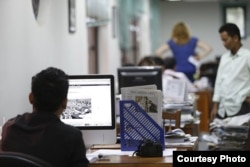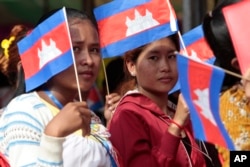Almost every day until his death in 2012, King Father Norodom Sihanouk sat at his desk, drank a glass of his customary tea or water and read The Cambodia Daily.
Sometimes what he saw there pleased him; other times, it enraged him. Frequently, he would scribble notes and annotations in the margins of the paper, photocopy them and disseminate them in his weekly bulletins.
Just two blocks from the Royal Palace, but a world away from its rarified milieu, tuk-tuk driver Ek Kran had a similar routine. Mr. Ek Kran, now 43, has parked along the riverside soliciting customers every day for the past 13 years. To pass the time and learn more about the world, he read The Cambodia Daily, even improving his English by comparing the newspaper’s stories in Khmer and English.
“The newspaper is independent, not taking sides. It gives constructive criticism,” he said.
The Cambodia Daily, which faces imminent closure after being slapped with a $6 million tax bill by the government last month, has a relatively small circulation in absolute numbers, printing just 4,000 to 5,000 copies per day. But with a readership ranging from ambassadors to security guards, from professors to rural schoolchildren, it has long had a disproportionately large influence, both here and abroad.
Cambodian journalists trained at the Daily now report for the local bureaus of Reuters, the Associated Press, Deutsche Welle and Radio Free Asia, as well as the Phnom Penh Post, the Khmer Times and numerous other local media outlets. Daily alumni have also gone on to work at the Asia Foundation, the opposition CNRP and the government’s Council of Ministers.
Outside of Cambodia, former Daily reporters work around the world at newspapers and wire services including the New York Times, the Associated Press, Agence-France Presse, the Washington Post and Bloomberg. The editor of Voice of America’s Khmer Service, Chris Decherd, is a former Cambodia Daily staffer, as are several members of VOA’s team in Washington and Phnom Penh.
The newspaper’s founding co-editor, Robin McDowell, won a Pulitzer Prize last year for her Associated Press coverage of slave labor on fishing boats in Southeast Asia. Another ex-Daily journalist, Thet Sambath, turned years of reporting for the Daily into an award-winning documentary on the Khmer Rouge, “Enemies of the People.” Multiple Cambodian journalists at The Cambodia Daily earned scholarships to study journalism abroad.
Stories from the paper have informed the work of foreign journalists and human rights advocates based in the region, as well as prosecutors, judges and defense lawyers at the Khmer Rouge tribunal, whose filings are studded with footnotes citing The Cambodia Daily’s reporting on the court.
Kingsley Abbott, a Bangkok-based legal adviser to the International Commission of Jurists who formerly worked as a lawyer at the Khmer Rouge tribunal, said the paper was essential to his understanding of Cambodia.
“Reading The Cambodia Daily has been part of my morning routine for over 10 years,” he said.
He added that he frequently cited the Daily’s reporting in his work, most recently in July, when ICJ called upon the Cambodian government to create a formal commission of inquiry into the killing of Kem Ley.
“I have many sources, but one mainstay over the years has been The Cambodia Daily and its journalists,” Mr. Abbott said.
Sophal Ear, an associate professor of diplomacy and world affairs at Occidental College, agreed. Mr. Sophal Ear studies Cambodia but lives in California, from where he uses local media like the Daily to keep up with events in the country.
“I used the paper’s articles in my books, in my own scholarly articles,” he said.
“I read the Daily every day as part of my routine. Reading it informs my work, and its closure makes me feel like the violinist on the Titanic who says, ‘Gentlemen, it has been a privilege playing with you tonight.’”
Straight to the Top
The newspaper has also had a significant impact on the Cambodian government and the long-ruling Cambodian People’s Party since it was founded in 1993 by American journalist and philanthropist Bernard Krisher.
Indeed, one of its most famous readers is Prime Minister Hun Sen, who has been pictured more than once with a copy of the Daily. Although he frequently criticizes the newspaper and has accused it of opposing his rule, he and other government officials have also acted upon information revealed in its stories.
The government has also permitted the Daily to publish uncensored for nearly 25 years, despite its often critical reports on illegal logging, official corruption and land disputes. This may be partly because the newspaper is a useful source of objective information, said Kevin Doyle, who edited the Daily from 2004 to 2014.
“King Norodom Sihanouk told Bernard Krisher that he considered the Daily as important as an intelligence service—particularly, he remarked, as no one would tell him what was really going on outside the palace,” Doyle said. “Now the government has Facebook.”
Mr. Doyle said he recalled a number of times that the Daily’s reporting directly affected government policy, most notably in a series of articles on Montagnard asylum-seekers who fled persecution in Vietnam by crossing into Cambodia along jungle pathways. At the time, the government claimed that there were no Montagnards hiding in Cambodia, but efforts by the Daily to find them and tell their stories made it clear that the refugees existed and were in desperate need of help, he said.
“In fact, in the Cambodia Daily’s 24-year history, that was probably our greatest impact on policy and people’s lives,” he said. “We actually saved many Montagnards from deportation, and who knows what other dangers from hiding for months on end in the border forests.”
Kuch Naren, who worked at the Daily for 15 years, agreed that her most enduring memories were instances when “articles printed in the Cambodia Daily made some positive change for the sake of public interest.”
After Ms. Kuch Naren reported a series of stories about rural Cambodian women who were trafficked to South Korea and Taiwan for marriage, she said, the government put a moratorium on Cambodian women marrying foreigners and took steps to establish clearer legal procedures for such marriages.
“This is one of the ways in which the media are crucial: exposing hidden information that has never been reported about, issues that government leaders need to work on,” she said.
Cambodians and The Daily
It is not just the wealthy and well connected who read the paper. The Cambodia Daily has been a part of the education of two generations of Cambodians, including many who lack the resources for expensive schooling.
The Daily’s English Weekly supplement is widely used in schools and among Cambodians who do not have access to English classes but wish to learn the language. Douglas Steele, the Daily’s general manager, said an extra 500 copies of the supplement were printed every week, in addition to those appearing in the paper.
Every morning starting at 6 a.m., You Sony, an English teacher based in Kampong Cham, holds an optional English class at her house for students who want to enrich their language skills, using a curriculum based on articles in The Cambodia Daily.
Ms. You Sony, 47, says she has been teaching English using the paper for almost 20 years.
“The students can learn a lot and they learn how to use vocabulary and gain much knowledge in writing,” she said.
Noan Sereiboth says he began reading the paper as a 17-year-old high school student in Kampong Cham and credits it with educating him about the political and social world beyond his immediate community.
“I really appreciate their work and reporting, which provides critical analysis and thinking and very in-depth insights,” he said. “It is like a library to search for the truth.”
Now 27, he lives in the capital, where he works for an NGO and is an organizer of Politikoffee, a popular political discussion group for youth. He still reads the newspaper every day and relies on it to bolster his understanding of current events.
“I felt bad when I heard it would be shut down,” he said.
A Symbol of Freedom
Beyond its readership, The Cambodia Daily has been allowed to operate for 24 years largely unimpeded by government interference or censorship, becoming a symbol of press freedom in a country whose television stations and Khmer-language newspaper tend to be biased toward the ruling party—if not owned outright by the government or pro-CPP businessmen.
Its forced closure has coincided with increased pressure on other media outlets, including more than a dozen local radio stations airing content produced by VOA, RFA, and the opposition CNRP. Last month, the government also ordered the closure of the National Democratic Institute, an NGO funded by the US that carries out pro-democracy work, and ordered its foreign staff to leave the country.
Moeun Chhean Nariddh, director of the Cambodia Institute for Media Studies, said that although he sometimes disagreed with the tone of the Daily’s coverage, finding it overly critical of the government, the fact that it was allowed to exist was important.
“It dares to touch sensitive stories related to corruption, forest destruction and politics,” he said.
George Edgar, ambassador of the European Union to Cambodia, said the Daily’s existence had contributed to making Cambodia one of the best countries in the region for freedom of the press.
“Cambodia has regularly been rated by organizations such as Reporters Without Borders as having one of the best records for media freedom in Southeast Asia,” he said in an email.
“That is partly a reflection of the work of the Cambodia Daily and other English-language newspapers, which have reported, often critically, on political and economic developments and have trained many young Cambodian journalists in investigative journalism.”
Mr. Sophal Ear, the Occidental College professor, said the closure of the Daily would have a symbolic as well as practical impact, “like a death sentence for freedom of the press in Cambodia.”
“The effect would be chilling,” he said. “Waking up to The Cambodia Daily every day, with its stories of official misdeeds, would be a thing of the past. Imagine that. In one fell swoop, one of the most consistent voices for justice in Cambodia, silenced.”
(Additional reporting and editing by VOA Khmer contributor Julia Wallace, a former Cambodia Daily editor)















